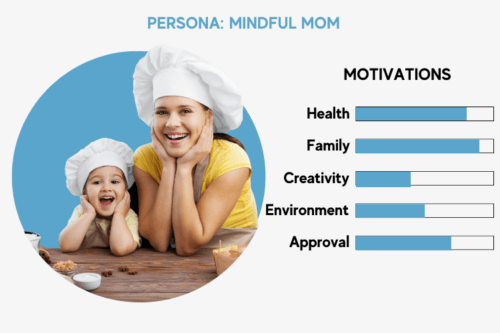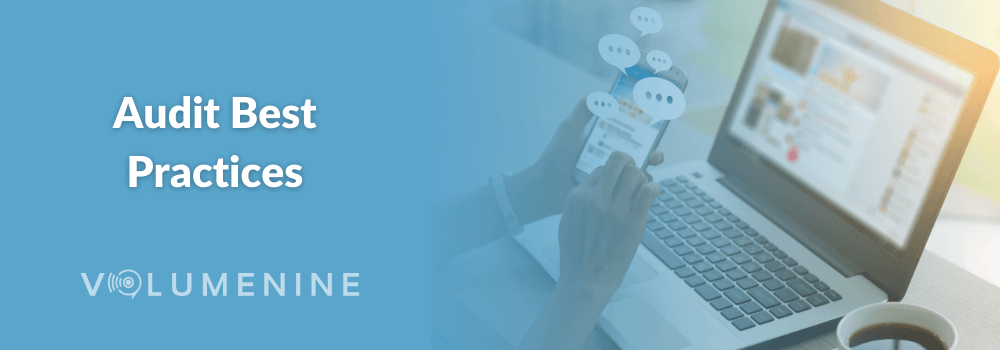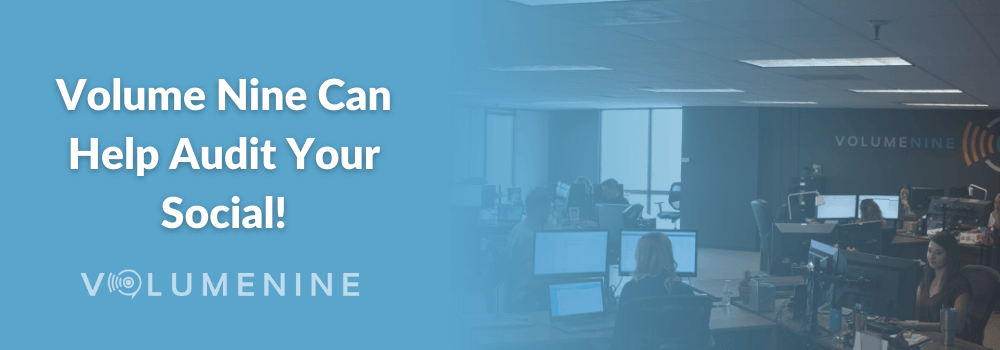How To Do a Social Media Audit
Concerned that your Social Strategy is a bit stale? Our comprehensive guide will teach you how to do your own social media audit, step by step.
Step-By-Step Social Media Audit Guide
Are you concerned that your social media marketing strategy is a little stale? Conducting a comprehensive audit of your social media accounts plus getting awareness of the social media channels your competitors utilize can help you optimize your social for your business goals. A great social media audit will allow you to:
- Set goals & focus on important social media metrics
- Align your social media efforts with your overall marketing plan
- Improve your brand’s social presence
Table of Contents
- What is a Social Media Audit?
- Step 1 – Get Clear on the Why & The Who
- Step 2 – Take Stock
- Step 3 – Audit Best Practices
- Bonus: Top Best Practice Audit Fails
- Step 4 – Analyze your Competitors
- Step 5 – Evaluate Top-Performing Content
- Step 6 – Develop a S.W.O.T.
- Step 7 – Go Forward Planning
- Volume Nine Can Help!
What Is A Social Media Marketing Audit?
“Audit” is probably an over-used term in our industry, so in a lot of ways, a social media audit can mean whatever it is you want it to mean.
That being said, we’ve worked with hundreds of brands over the last decade, and here’s what businesses really need when it comes to a social media audit:
- Re-evaluate the business goals & strategy tied to social
- Take stock of what they’re actually doing & spending money on
- Identify where they aren’t up to date on best practices
- Take a look at what competitors are doing
- Evaluate recent posts
- Decide on your path forward – both strategically & tactically
Step #1 – Get Clear on the Why & The Who
Whether you are performing the audit yourself or hiring an outside agency like Volume Nine to conduct your audit, it’s critical you spend a little time organizing your social media marketing goals and KPIs (Key Performance Indicators).
A Few Common Social Media Goals & Key Metrics
- Goal: Brand Awareness
- KPIS: Number of Followers, Impressions, Reach
- Goal: Improve Brand Sentiment
- KPIS: Lack of unfollows, Reshares, Positive vs. Negative Mentions
- Goal: Increase Brand Recall
- KPIS: Reach, Engagement
- Goal: Leads / Revenue
- KPIs: Social Conversion Rates, Assisted Social Conversion
- Goal: Partnerships (e.g. retailers or affiliates)
- KPIS: Follower Count & Rate of Follower Growth
Building Social Media Personas
Persona work can be as easy or as complicated as you let it. Early in my career, I had the opportunity to work at a Market Research firm, and persona work involved focus groups, and in-depth interviews and could run you $20k+ for each persona. However, for many brands, that’s probably overkill.
Instead, take some time to outline the different buyer personas you know your brand has. If you aren’t sure, some good places to start include:
- Doing a quick review of your current, top customers
- Ask your sales teams for their thoughts on your target audience
- Dig into your social media to gain audience insights & current engagement metrics
- Check Google Analytics to capture persona data
From there, think through some of the demographic & psychographic characteristics each persona might have. Remember, this doesn’t have to be perfect, just good enough.
- Examples of audience demographics: where they live, age, gender, income, etc.
- Examples of audience psychographics: what their problems are, why they buy certain things, who influences them, what they are entertained by, etc.
Step #2 – Take Stock – AKA What the heck are we doing now?
The key here is to just get your arms around what you’ve actually got happening right now:
- What platforms are we actively managing?
- Are there any platforms out on the world wide web that look like us, but isn’t us?
- How much money are we spending on each platform?
- How much time are we investing in each platform?
- How has each platform performed in the last year against our goals (might use a combination of Google Analytics & Social Media Analytics)?
Step #3 – Analyze The Basics
This is a key step in the process for any Social Media Audit. Unfortunately, there isn’t a great automated tool that can perform this for you. At Volume Nine we put all of our social media heads together and put together a proprietary green / yellow / red flag review based on core best practices.
Here’s a social media audit checklist for best practices for some of the top social media platforms:
FACEBOOK (META) BEST PRACTICES
- Verified
- Complete Profile Info
- High-quality profile picture & cover photo
- Content that’s “on brand”
- High-quality Images & Graphics
- Consistent Posting Cadence
- Use of Video
- Engagement Baseline
- Utilizing Paid Boosting
- Link Sharing
- Engagement vs. Offer Content Ratio
- Copy & Creative Appropriate for Platform (e.g. use of hashtags)
- Responsiveness
INSTAGRAM BEST PRACTICES
- Instagram Account Verification
- Posting Cadence
- Images or Graphics
- Grid Approach
- Stories
- Story Highlights
- Instagram Reels & Instagram TV
- User Generated Content
- Content Categories
- Utilizing Paid Boosting
- Engagement Baseline
- Copy & Creative Appropriate for the Platform (e.g. use of hashtags)
- Responsiveness
LINKEDIN BEST PRACTICES
- About section filled out & optimized
- Posting Cadence
- Images or Graphics
- Use of Video
- Post Engagement
- Engagement Baseline
- Copy & Creative Appropriate for the Platform (e.g. use of hashtags)
- Tagging
- Sharing
TWITTER BEST PRACTICES
- Complete Profile Info
- High-Quality Profile Pic & Cover Photo
- Content “on brand”
- Consistent & Frequent Posting Cadence
- Engagement Baseline
- Engagement Response
- Utilizing Paid Boosting
- Engagement vs. Offer Content Ratio
PINTEREST BEST PRACTICES
- Board Completion
- Number of Boards
- Engagement
- Images or Graphics Optimized
- “About” section filled out & optimized?
- The Website and Page are Confirmed
TIKTOK BEST PRACTICES
- Complete Profile Info
- Content “on brand”
- Consistent posting Cadence
- Video content appropriate for the platform
- High engagement value early on in videos
- Use of hashtags
YOUTUBE BEST PRACTICES
- Complete Profile Info
- Consistent posting cadence
- On-brand, high-quality content
- Video descriptions on each video
- Videos descriptions optimized for SEO
- Testing content variety
- Closed captions included
- Responding to comments
**Bonus – Most Common Audit Fails**
We’ve done a lot of audits, and a lot of brands struggle with the same issues. Here are the top 6 audit fails we’ve seen across the major social media profiles in the past 3 years:
- Tone & Personality – Is your social media tone really dry, straightforward and uber-professional? It’s time to evaluate how you can let your brand personality breathe a little bit. Need a little help, here’s our brand personality guide.
- Engagement – The beauty of Social Media is that it’s a 2-way dialogue. Spend time encouraging your audience to get involved in the conversation. Here’s our in-depth social media engagement guide that outlines exactly how to do this.
- Paid Boosting – Noticing your competitors are getting 100s of likes and dozens of comments, but your feed is crickets? If it’s worth posting, it’s worth putting a few bucks behind it to get visibility.
- Social Media Content is Too Salesy – We get it, you’re investing in social media so you want to get sales out of it. But if you’re feed is too salesy, you are going to kill your social growth and you’ll actually see your sales from social fall off.
- Off Brand Creative – Yay, someone on your team learned how to use Cava! Just because it looks cool doesn’t mean it looks like you. Having consistent branding is extremely important if you want to consistently improve your top metrics.
- Duplicating Content Across Platforms – So many brands think “well as long as we’re posting on Platform 1, let’s just toss it on Platform 2.” If you want to commit to a platform, it’s important to update your creative, copy & strategy to really fit that platform. Here’s a link to how to repurpose content across social
Step #4 – Conducting a Competitive Analysis
Competitive Analysis on social media can be tricky. Just because someone is your traditional competitor doesn’t mean they’ll necessarily be your top social competitor. Additionally, the real trick with social media is to add your own flair to whatever you do. However, checking out competitors, as well as aspirational brands, can be a great tactic to get set some targets + get the creative juices flowing.
Great things to look at to analyze your competitor’s social media efforts:
- Benchmarks – Followers & post engagement levels
- Content Variety – Types of content in their content strategy
- Top Performing Content – What types of content seem to be resonating the most with their audience
- Poor-Performing Posts – What types of posts to avoid
Also, unless you are prepared to toss down some serious green for a tool, there aren’t a whole lot of great, low-cost social analytics tools out there. That being said, one great tool to consider having in your arsenal is buzzsumo.
Otherwise, sometimes spending time to manually pop through competitors’ feeds can give you a lot more insight than a fancy analytics tool can. One thing you can also do is peruse through your competitor’s ads by going to Page Transparency -> Go To Ad Library.
Step #5 – Evaluate Your Best-Performing Posts
Understanding what is and isn’t working well for your content can be a great starting point for your go-forward strategy.
However, as you evaluate your top-performing posts, try to spend time thinking through the “why.” Was it the copy, was it the creative, what time of day did you post it, did you put any boosting dollars behind it, etc.? Also, remember that engagement rate is an important metric in social algorithms and should be considered a top indicator of success.
If you are evaluating content based on things like website traffic & conversions, then one thing you can also do is append UTMs to the end of any URL you share on social. That way you can generate reports in Analytics that dig right into the data you need most.
Additionally, if your brand utilizes social media scheduling tools, such as Hootsuite, HeyOrca!, or Sprout Social they’ll generally have some built-in analytics you can also leverage.
Step #6 – Develop a S.W.O.T. for Social
Once you spend a good hunk of time going through your goals, your data, your top content & and your competitors, one of the best ways to get your thoughts organized is to make a SWOT (Strengths, Weaknesses, Opportunities, Threats).
- Strengths: What things are you already doing better on social than others? Or what assets or budget do you have in your arsenal that you can leverage?
- Weaknesses: What are some areas where competitive brands seem to be stronger at the moment?
- Opportunities: Where do you see opportunities for improvement or try new things?
- Threats: If you fast-forward one year and your social media program hasn’t improved, what likely caused that?
Step #7 – Go Forward Planning
To this point, you are getting organized, getting clear, and getting the lay of the land. Go-forward planning is the part where you get your creative juices flowing.
- Stuff to Fix – Did you find that you are doing some stuff that’s cringe-worthy? Don’t worry, it’s a new day. Create a list, fix that stuff, and don’t look back!
- Content Categories – Creating regular social media calendars is hard work. Unless you want to give your audience a bunch of useless filler content like “Happy Donut Day,” it helps to outline the major buckets of content you want to create going forward. Stuck on good ideas for content categories? We have a big ‘ol list of ideas here that you can use.
- Ideas – Once you have your content categories, it’s a heck of a lot easier to start filling out ideas for your content and engagement strategies going forward. What kinds of things do you want to create? What creative ideas do you have to get engagement flowing?
Volume Nine Can Help!
Hey there! If you’re looking for some help with your social media game, Volume Nine might just be the answer. We’re a digital marketing agency that specializes in social media, and we can help you with everything from creating a killer social media strategy to executing it flawlessly.
Our social media audits are also the bees knees, and can be super helpful if you’re not sure where to start (or if your to-do list is already a bit stacked). We’ll take a deep dive into your social media presence and analyze everything we’ve got listed above. From there, we’ll provide you with a report that outlines what’s working well, what could be improved, and what opportunities you might be missing out on.
Also, I think you are going to LOVE our audit. But, if you get to the end and the juice wasn’t worth the squeeze, we’ll refund your money.
Whether you’re a small business owner, a social media manager, or a head of marketing, my team and I are ready to help get your social where you want it to be!
– Natalie Henley, CEO Volume Nine











